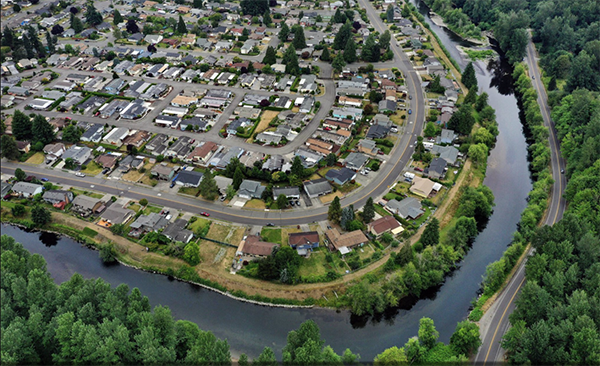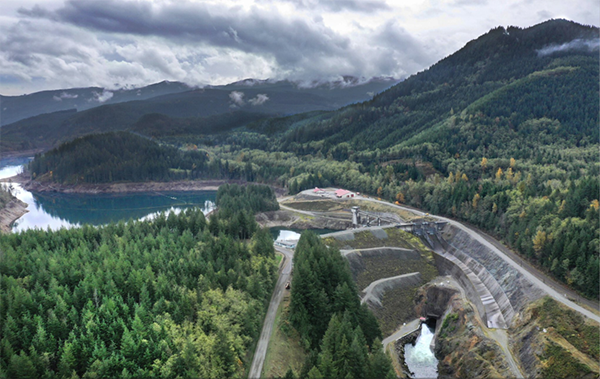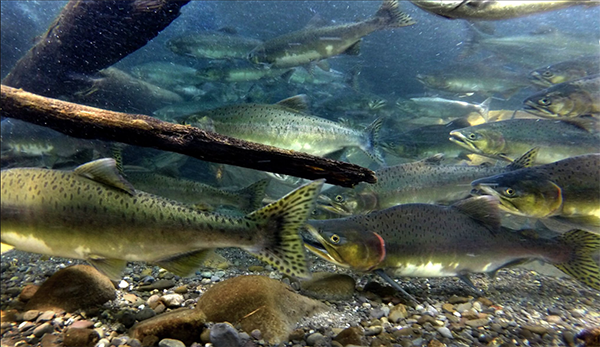||| FROM SEATTLE TIMES |||
ON A COLD, foggy morning in the summer of 2019, I made my way to a boat ramp, hard by homeless encampments and under the roaring traffic of a highway overpass in Seattle, to watch and talk with Muckleshoot tribal members bringing in their catch. Some 90 boats turned out for what was only a 12-hour opening — all the river could support for this treaty-protected fishery that year.
But there they were: big, beautiful Chinook, still silver bright from the sea. In this setting, they seemed as unlikely and out of time as dinosaurs. And yet these people, and these fish, the river’s first inhabitants, were still here.
The Muckleshoot Indian Tribe has invested heavily in the Green-Duwamish River, and its treaty entitles them to half the salmon catch. But half of next to nothing is just about nothing. The catch was so small in this briefest of openings that there would not be another fishery allowed that season, despite the treaty’s promise.

Muckleshoot tribal members had only 12 hours of treaty-protected fishing in Elliott Bay and the Duwamish in 2019 because Chinook runs were so poor. (Steve Ringman / The Seattle Times)
These losses were not so much intentional as not thought about. They didn’t matter to the settlers who remade this place. Historian Coll Thrush at the University of British Columbia, in his superb article “City of the Changers” in Pacific Historical Review, notes the remarkable lack of concern as newcomers blew up, carved up, re-plumbed, and remade the lands and waters where they had only recently arrived.
“The people who did all this thought they were improving on nature; they thought they were making it better and more efficient,” Thrush told me. “They really thought they were doing the right thing, and they were completely dismissive of the effects on the salmon and Indigenous people, which are really the same story. You had Indigenous people starving within sight of the Smith Tower [in Seattle]; there were no fish.”

Houses are built right up to the Green River’s levee in Auburn. (Steve Ringman / The Seattle Times, 2019)
Thrush grew up in Auburn and knows its landscape. He sees an unreconciled history held in this land and its people. “I feel like Seattle and Puget Sound is still coming to terms with its own past and the consequences of that past,” Thrush said. “We are all inside that story; we are all part of it — we have a right to speak of it and a responsibility to speak of it.”

The Howard A. Hanson Dam, built in 1962, blocks fish passage to half the Green River watershed, including nearly all its best salmon habitat. Providing fish passage would open 100 miles of spawning habitat for Chinook, coho and steelhead. (Steve Ringman / The Seattle Times, 2018)
These lands and waters also speak for themselves, in layers of history and time, read in pollen records and shell middens, in extirpation, in displacement and persistence. And even in the memories of matriarch orcas like L25, still here through more than eight decades.
“The orcas — they know; they have seen it all,” Thrush said. “They haven’t seen the dam on Eagle Gorge on the Green, but they have seen its effects; we are past the point of thinking they are ‘just animals’ without consciousness. What might the story look like from their perspective?
Long-lived, the southern resident orcas are repositories of memory and experience, and they have witnessed so much change in less than two generations. “They have their own histories that they carry,” Thrush said. “They are an archive.”
IT IS DIZZYING to think of the changes one extended family of orcas has been forced to contend with. L25 was born in about 1928, before the first dam on the Columbia, Rock Island, was built, and Bonneville Dam was still another decade away. There was no Hanford Nuclear Reservation, no Grand Coulee Dam; there were no dams on the Lower Snake River. The state’s population was about 1.5 million people.
Over L25’s lifetime, the state’s population has grown to nearly 8 million, with no end of growth in sight. As the region booms, salmon and orcas are in a race against time. Under siege since the settlers arrived with their draglines and steam shovels and suction-pump dredges, the threats to the southern residents’ home waters have metastasized.
Beyond the Seattle area, where the destruction started, are some of the region’s fastest-developing landscapes: the suburbs. More growth means more people and, depending on how growth is managed, more pollution and more runoff, as forests and open spaces that absorb the heavy rains and filter pollution are paved over or converted to housing, shopping centers, office parks and all the rest. With the urban core already built out and devoured, what is happening here now is destroying the best of what is left.
Editor’s note: This is an edited excerpt from Lynda V. Mapes’ book “Orca: Shared Waters, Shared Home,” which will be published June 1, with photographs by Seattle Times photographer Steve Ringman.

About the book
Lynda V. Mapes’ new book, “Orca: Shared Waters, Shared Home,” with photos by Steve Ringman of The Seattle Times, is based on the award-winning 2018-19 Seattle Times series Hostile Waters. The book, copublished by The Seattle Times and Braided River, will be available June 1.
More information: To pre-order the book, register for the book launch and see more events, go online to the book’s website, orca-story.com.
READ FULL ARTICLE: www.seattletimes.com/pacific-nw-magazine/were-changing-the-habitat-for-the-orcas-and-salmon-and-not-for-the-better/
**If you are reading theOrcasonian for free, thank your fellow islanders. If you would like to support theOrcasonian CLICK HERE to set your modestly-priced, voluntary subscription. Otherwise, no worries; we’re happy to share with you.**








What a wonderful article! A very clear picture of what we are quickly loosing. The author clearly delineates, in a heartfelt way, what our beautiful Orcas have lost and what we are loosing.
Ah-HO! All My Relations.
Spirit Eagle
This is the same sad story , the world around . When , as intelligent adults , can we start talking and then doing something about over population ?